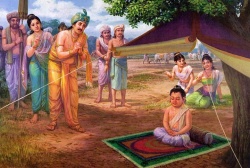Five guides for propagation
five guides for propagation
[五綱] (Jpn go-ko )
Five criteria for propagating Buddhism:
(1) the teaching,
(2) the people's capacity,
(3) the time,
(4) the country, and
(5) the sequence of propagation.
Nichiren (1222-1282) established these five guides as a standard to demonstrate the correct way to propagate his teaching of Nam-myoho-renge-kyo in his time and in the future. They are set forth in his writings The Teaching, Capacity, Time, and Country and What It Means to Slander the Law. While Nichiren discusses the five guides in reference to what teaching one should propagate in Japan in his day, they are universally applicable. The five may be briefly explained as follows:
(1) A correct understanding of the teaching. This means to recognize the differences among the many Buddhist teachings and discern which are profound and which are superficial. Nichiren established the fivefold comparison for this purpose. Ultimately, to recognize that the Lotus Sutra stands supreme among all the sutras, and that Nam-myoho-renge-kyo of the Three Great Secret Laws implicit in the "Life Span" (sixteenth) chapter of the Lotus Sutra is the teaching that enables all people in the Latter Day of the Law to attain Buddhahood, is to have a correct understanding of the teaching.
(2) A correct understanding of the people's capacity. Capacity means the life-tendency of the people, the nature of their connection to Buddhism (or lack thereof), and their ability to understand and believe in the Buddhist teachings. In short, to understand the people's capacity means to know by what teaching they can attain Buddhahood. According to Nichiren, the people of Shakyamuni's time and of the Former Day and the Middle Day of the Law had already received the seed of Buddhahood from him in the remote past and nurtured it through Buddhist practice in previous existences. Therefore Shakyamuni's Lotus Sutra was the teaching most appropriate to benefit them by enabling them to reap the "harvest" of Buddhahood. In contrast, the people of the Latter Day have not yet received the seed of Buddhahood, and must therefore receive the seed of enlightenment by practicing the Buddhism of sowing. To recognize this is to have a correct understanding of the people's capacity.
(3) A correct understanding of the time. The development of Buddhism following Shakyamuni's death is divided into three periods, known as the Former Day, Middle Day, and Latter Day of the Law. The Former Day is the time in which Shakyamuni's teaching is transmitted correctly and leads many people to enlightenment. The Middle Day is the period in which, though Shakyamuni's teaching is practiced, the practice gradually becomes a formality and benefits fewer and fewer people. In the Latter Day, the teaching is obscured and lost, no longer leading people to enlightenment. Shakyamuni offered enlightenment for the people of the Latter Day, however. In the Lotus Sutra, he implied the teaching to be propagated in that age and the person who would propagate it. The Law that is to spread in this time period is Nam-myoho-renge-kyo, the essence of the Lotus Sutra, and the person who will spread it is Bodhisattva Superior Practices, the leader of the Bodhisattvas of the Earth, to whom Shakyamuni has entrusted the task. To know this is to correctly understand the time. Nichiren regards himself as fulfilling the mission of Bodhisattva Superior Practices.
(4) A correct understanding of the country. This means to discern the nature of a particular nation's or society's connection to Buddhism. Nichiren states that some countries actively slander the correct teaching, some are completely ignorant of it, some are exclusively Hinayana, some exclusively Mahayana, and others both Hinayana and Mahayana. Japan is an exclusively Mahayana country, he says, that is filled with people who slander the correct teaching. He concludes, therefore, that the Mystic Law of Nam-myoho-renge-kyo, which can save all people including even those who oppose it, should be spread in Japan.
(5) A correct understanding of the sequence of propagation. The point of this criterion is that one should not propagate a teaching inferior to those that have already spread. Nichiren points out that in a country such as Japan, where the theoretical teaching (first half) of the Lotus Sutra has already been spread (by Dengyo, the founder of the Tendai school, during the Middle Day of the Law), the essential teaching (latter half) of the sutra—specifically, the teaching implicit in the "Life Span" chapter—should be propagated. To recognize this is to have a correct understanding of the sequence of propagation.
